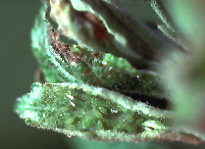 Apple Grain Aphid, Rhopalosiphum fitchii
(Sanderson)
Apple Grain Aphid, Rhopalosiphum fitchii
(Sanderson)
[= R. insertum (Walker)]
I. Introduction: Apple grain aphid (AGA)
rarely causes damage to apple. But since it is
generally the first to appear on apple buds in the spring and is
often
abundant, it often arouses
the concern of the grower.
II. Hosts: The primary hosts, on which eggs are placed for
the
winter, are apple, hawthorn,
pear, quince and plum. During the spring and summer, this aphid
moves
to various grass species.
III. Description: The overwintering eggs are a shiny black,
indistinguishable from the other
aphids overwintering on apple. Newly hatched nymphs are a dark
green
color. There is a slightly lighter
green area running down the back (Plate 41). The antennae, legs
and
cornicles are very dark. The antennae
are short, reaching about to the end of the thorax. Those of young
rosy
apple aphid stem mothers reach
to about half the length of the abdomen. The cornicles of AGA
nymphs
are short, barely swollen discs.
The young nymphs are generally hard to distinguish without
magnification, unfortunate given the great
disparity of damage potential between the species. The mature stem
mother is 8/100 inch (2-2.15 mm)
long. The mature aphids have a darker green stripe along the
middle of
the back.
The oviparae, or egg-laying females, are a pale, yellow-green,
usually
with a pale reddish spot
at the base of each cornicle. Unfortunately, this description also
applies to the oviparae of the other
aphids on apple. AGA oviparae possess only five antennal segments;
RAA
and the GA complex have six
segments. Furthermore, RAA oviparae have a prominent central
tubercle
on the front of the head.
IV. Biology: The eggs of AGA are not killed by periods of
warm
weather during the winter as
are those of AA. These eggs hatch 7-10 days earlier than those of
GA
and RAA Eggs hatch as buds swell,
and young aphids may be found clustered on buds at silver tip. The
stem
mothers become mature about two
weeks after hatch. They begin to produce new nymphs about 24-36
hours
after the last molt. Stem mothers
produce an average of 75 young, over a period of about 30 days.
Most of the second generation AGA develop wings and leave the
apple
tree. A few reproduce on the tree.
The cornicles are cylindrical, with the base and end slightly
constricted but with the end flaring. The
dark green stripe is present along the dorsum in this generation
as
well. The third generation is much
less abundant; aphids of this generation develop into winged
adults,
dispersing to summer hosts.
During the summer, many generations develop on a variety of
grasses and
cultivated grain crops. In
the fall, with the onset of cool weather, winged migrants are
produced
which return to apple and other
primary hosts. Many migrants die through normal fall leaf
abscission.
The migrants are of two
types. The first is the viviparous female, the second is the male,
produced for the first and only
time during the season, and arriving on the tree about a week
after the
female migrants. Once migrant
females have reached the winter host, wingless, sexual females
(oviparae) are produced which produce the
overwintering eggs after mating with the males.
V. Injury: Although these aphids may be present in great
numbers, damage is rarely inflicted
on the apple buds.
This is taken primarily from a chapter by
D.G.
Pfeiffer, L.A. Hull, D.J. Biddinger, & J.C. Killian on apple
indirect pests, reprinted with permission from Mid-Atlantic
Orchard
Monitoring Guide, published by NRAES, 152 Riley-Robb Hall,
Ithaca,
New York 14853-5701.
Back to Virginia
Apple
Page
Back to Home Page for "Arthropod Management
in
Fruit Crops" course
Back to Virginia
Fruit
Page